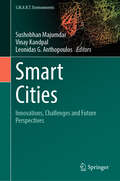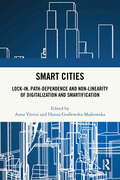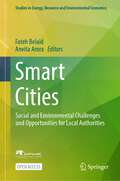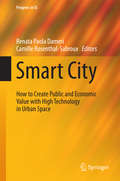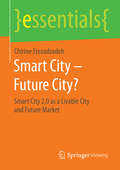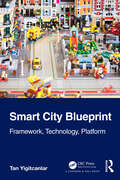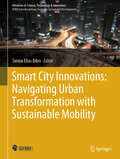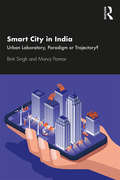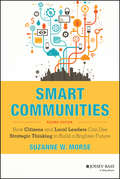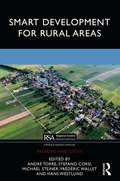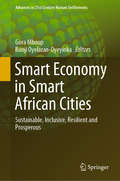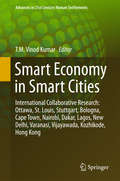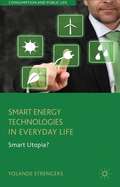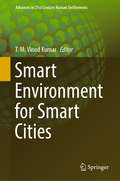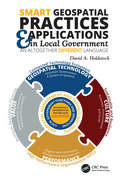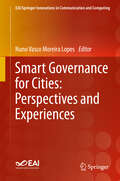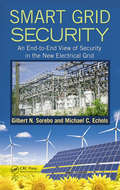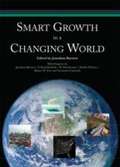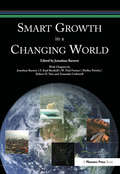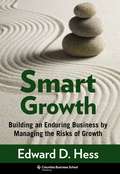- Table View
- List View
Smart Cities: Innovations, Challenges and Future Perspectives (S.M.A.R.T. Environments)
by Leonidas G. Anthopoulos Sushobhan Majumdar Vinay KandpalThis book aims to integrate new technologies and adaptation tools into the process of smart city planning. It also emphasizes the value and importance of modern technologies such as IoT and data science as a smart technology for the formation of a smart city. The authors believe that various technologies in a smart city will reduce all the problems for the sustainable growth and future prospects of the city. The first section of this book discusses the innovation of new technologies (AI, data science, block chain, etc.) that has flourished in recent decades which will make the city smarter. This section also describes that block chain and IoT (Internet of Things) are two transformative technologies that can greatly impact smart cities by enhancing security, improving transparency, and enabling efficient management of resources. The second section of the book explains about the uses of AI tools and smart technologies (like waste management, public safety and security) for the development and management of smart cities. This chapter also describes AI-powered systems that are integrated into smart buildings to optimize energy usage, enhance occupant comfort, and improve building management. These systems can adjust lighting and HVAC settings based on occupancy, learn user preferences, and provide personalized energy efficiency recommendations. The third portion of the book investigates the recent challenges and barriers of smart city that have been faced by the smart cities in the recent decades. This section also describes various challenges and barriers for the implementation of IoT sensor, AI technologies, etc., for the formation of a smart city. The future prospects of a smart city are the main theme of the last chapter. In this section, an attempt has been made about the future vision and outlook of the smart city. This chapter also describes different approaches (like smart grid, societal smart city, smart city model, etc.) for the future planning and management of the city.
Smart Cities: Lock-in, Path-dependence and Non-linearity of Digitalization and Smartification (Advances In Science, Technology And Innovation Ser.)
by Anna Visvizi Hanna Godlewska-MajkowskaThis book seeks to identify and to examine factors and mechanisms underlying the growth and development of smart cities.It is commonplace to discuss smart cities through the lens of advances in ICT. The resulting overemphasis on what is technologically possible downplays what is politically, socially and economically feasible. This book, by analysing the smart city through a variety of perspectives, offers a more comprehensive insight into and understanding of the complex and the open-ended nature of the growth and development of a smart city. A solid conceptual framework is developed and employed throughout the chapters, and a selection of case studies from Europe, Asia, and the Arab Peninsula grants the readers a hands-on perspective of the matters discussed.The chapters included in this book address a set of questions, including: How do the twin-processes of digitalization and smartification unfold in the context of the smart city agenda? How do these processes relate to the concepts of smart city 1.0, 2.0., 3.0. and 4.0? In which ways have the spatial aspects of city functioning been influenced by the intrusion of ICT? In which ways do the same processes contribute to the attainment of the UN Sustainable Development Goals (SDGs)? What are the implications of smartification and the emergence of smart organizations (public, private, and voluntary) for the spatial development of smart cities? Do ICT and its application in the city space boost the processes of revitalization and how does ICT influence the process of gentrification? To what extent and how does the intrusion of ICT-enhanced tools and applications in the city space impact on a city’s relationship with its broader territorially defined context? Are the administrative borders and divisions inherent in the fabric of a city becoming less/more porous? How should urban sprawl be conceived in the context of the smart city debate? This book will have a broad appeal to academics, students, and policy makers with interests in urban planning, sustainable development, cities, economics, technology, sociology, urban studies, digitalization, SDGs, wellbeing, and resilience.
Smart Cities: Social and Environmental Challenges and Opportunities for Local Authorities (Studies in Energy, Resource and Environmental Economics)
by Fateh Belaïd Anvita AroraThis edited volume discusses the socioeconomic, environmental, and policy implications of smart cities. Written by international experts in energy economics and policy, the chapters present wide range of high quality theoretical and empirical studies at the nexus of social, entrepreneurial, governmental and ecological transformation. The book covers a wide range of topics, with a view towards providing empirical evidence of the benefits of smart cities as well as practical frameworks for smart city initiatives. Topics discussed include: smart city transition pillars, innovation for smart and sustainable cities design and implementation, smart city governance, smart mobility within cities, and smart cities in emerging economies. This volume will be of use to students and researchers interested in resource economics, energy economics, sustainability, ICT, and governance, as well as policymakers working on smart city initiatives.This is an open access book.
Smart Citizens, Smarter State: The Technologies of Expertise and the Future of Governing
by Beth Simone NoveckGovernments make too little use of the skills and experience of citizens. New tools--what Beth Simone Noveck calls technologies of expertise--are making it possible to match citizen expertise to the demand for it in government. She offers a vision of participatory democracy rooted not in voting or crowdsourcing but in people's knowledge and know-how.
Smart City
by Camille Rosenthal-Sabroux Renata Paola DameriThis book presents a comprehensive overview of the various aspects for the development of smart cities from a European perspective. It presents both theoretical concepts as well as empirical studies and cases of smart city programs and their capacity to create value for citizens. The contributions in this book are a result of an increasing interest for this topic, supported by both national governments and international institutions. The book offers a large panorama of the most important aspects of smart cities evolution and implementation. It compares European best practices and analyzes how smart projects and programs in cities could help to improve the quality of life in the urban space and to promote cultural and economic development.
Smart City - Future City?: Smart City 2.0 as a Livable City and Future Market (essentials)
by Chirine EtezadzadehThe concept of a livable smart city presented in this book highlights the relevance of the functionality and integrated resilience of viable cities of the future. It critically examines the progressive digitalization that is taking place and identifies the revolutionized energy sector as the basis of urban life. The concept is based on people and their natural environment, resulting in a broader definition of sustainability and an expanded product theory. Smart City 2. 0 offers its residents many opportunities and is an attractive future market for innovative products and services. However, it presents numerous challenges for stakeholders and product developers.
Smart City Blueprint: Framework, Technology, Platform
by Tan YigitcanlarThe smart city movement, during the last decade and a half, advocated the built environment and digital technology convergence with the backing of institutional capital and government support. The commitment of a significant number of local governments across the globe, in terms of official smart city policies and initiatives, along with the constant push of global technology giants, has reinforced the popularity of this movement. This two-volume treatment on smart cities thoroughly explores and sheds light on the prominent elements of the smart city phenomenon and generates a smart city blueprint. This first volume, with its 12 chapters, provides a sound understanding on the key foundations and growth directions of smart city frameworks, technologies, and platforms, with theoretical expansions, practical implications, and real-world case study lessons. The second companion volume offers sophisticated perspectives on the key foundations and directions of smart city policies, communities, and urban futures, with theoretical expansions, practical implications, and real-world case study lessons. This book is an invaluable reference source for urban policymakers, managers, planners, practitioners, and many others, particularly to benefit from it when tackling key urban and societal issues and planning for and delivering smart city solutions. Moreover, the book is also a rich and important repository for scholars and research and undergraduate students as it communicates the complex smart city phenomenon in an easy to digest form, by providing both the big picture view and specifics of each component of that view. It also appeals to local government agencies and smart city practitioners.
Smart City Innovations: Navigating Urban Transformation with Sustainable Mobility (Advances in Science, Technology & Innovation)
by Simon Elias BibriThis book offers a comprehensive exploration of the intersection of urban planning, transportation, technology, and smart city development. With a keen focus on sustainability and the potential for positive change, it presents a collection of diverse chapters that shed light on emerging trends and innovative solutions in the field. The book examines the role of urban ropeways as both a public transport service and a catalyst for touristic development, highlighting their potential benefits and challenges. It also introduces novel approaches to measuring accessibility and transportation potential using Space Syntax and Geographic Information Systems (GIS), providing valuable insights for urban planners and policymakers. The chapters delve into specific areas of study, such as the driving behavior of individuals with high-functioning autism spectrum disorder, the mobility challenges faced by women in developing countries, and alternative methods of snow and ice removal in parkingareas through hydronic heating. Furthermore, the book explores the intersection of sustainability, smart cities, and global travel, considering the impact of aviation on climate change and the potential of digital humanism in the metaverse. It also examines the implications and challenges of cultural biases in smart city development, emphasizing the need for inclusive and culturally sensitive approaches. The integration of Internet of Things (IoT) in housing is discussed, focusing on the domotization of sustainable walls and their potential benefits for energy efficiency and sustainable living. The use of immersive technologies in virtual heritage is explored, showcasing innovative tourist experiences and highlighting the case of the Berati Ethnographic Museum. The book also addresses the potential of web mapping applications for smart city development, the behavioral attitudes toward ridesharing and mode preferences of shared automated electric vehicles, the development of wind turbine systems for vehicle battery recharging, and the application of knowledge-driven problem identification in transformative city design and development. “Smart City Innovations" serves as a valuable resource for researchers, professionals, policymakers, and anyone interested in the future of urban planning, transportation, and smart cities. By addressing pressing challenges and presenting innovative solutions, this book aims to inspire positive change and contribute to the creation of sustainable and livable urban environments.
Smart City in India: Urban Laboratory, Paradigm or Trajectory?
by Binti Singh Manoj ParmarThis book is a critical reflection on the Smart City Mission in India. Drawing on ethnographic data from across Indian cities, this volume assesses the transformative possibilities and limitations of the program. It examines the ten core infrastructural elements that make up a city, including water, electricity, waste, mobility, housing, environment, health, and education, and lays down the basic tenets of urban policy in India. The volume underlines the need to recognize liminal spaces and the plans to make the ‘smart city’ an inclusive one. The authors also look at maintaining a link between the older heritage of a city and the emerging urban space. This volume will be of great interest to planners, urbanists, and policymakers, as well as scholars and researchers of urban studies and planning, architecture, and sociology and social anthropology.
Smart City: A Critical Assessment (The City Project #6)
by Giovanni Leoni Dario CostiThis contributed volume reports on a multidisciplinary collective work on the topic of Smart City, merging scientific reflections and operational issues. Here, current Smart Cities concepts are subjected to criticism, while the related terminology has been updated to contemplate a model of urban development capable of integrating technical and humanistic culture by fostering an open dialogue between different stakeholders. Upon an introduction to the state of the art, this book presents a glossary of definitions and concepts around the contemporary city, and five interviews with researchers and scholars of different background. The last chapter summarizes current challenges in designing the city of the future, highlighting new research directions in home-infrastructure, small smart city, energy transition, connectivity, digitalization and autonomous and connected mobility.Written by the members of the Scientific Committee of the Smart City 4.0 Sustainable LAB ResearchLaboratory, an inter-university network including research groups from the University of Parma, University of Modena and Reggio Emilia, University of Bologna, University of Ferrara, the Polytechnic University of Milan, and the Catholic University of Milan with its Piacenza campus, this book offers a source of inspiration for other researchers and stakeholders, and it is intended to foster collaborations between different stakeholders - and possibly countries – to develop future cities that are wise, green, sustainable and inclusive.
Smart Communities
by Suzanne W. MorseThe new edition of the acclaimed guide to strategic decision-making in community planning, development, and collaborationBased on the results of more than a decade of research by the Pew Partnership for Civic Change, Smart Communities provides directions for strategic decision-making and outlines the key strategies used by thousands of leaders who have worked to create successful communities. Outlining seven "leverage points" for decision-making used by thousands of leaders who have worked to create successful communities, this new Second Edition offers leaders from both the public and private sectors the tools they need to build a civic infrastructure and create a better future for all the community's citizens.Second Edition has been thoroughly updated with current knowledge and researchCovers new developments from current design thinking and strategy literature to innovation and invention in communitiesAdvises on how to create community readiness that will help avert problems before they beginAll case vignettes have been revised to include more detailed information about the process and application of the seven leverage pointsExamples from communities around the country illustrate how these change agents' well-structured decision-making processes can be traced to their effective use of the seven key leverage pointsSmart Communities offers hope to those who are striving to improve their communities and addresses vital issues such as poverty, race relations, and children's health and welfare.
Smart Design: Disruption, Crisis, and the Reshaping of Urban Spaces
by Richard HuThis book tackles the emerging smart urbanism to advance a new way of urban thinking and to explore a new design approach. It unravels several urban transformations in dualities: economic relationality and centrality, technological flattening and polarisation, and spatial division and fusion. These dualities are interdependent; concurrent, coexisting, and contradictory, they are jointly disrupting and reshaping many aspects of contemporary cities and spaces. The book draws on a suite of international studies, experiences, and observations, including case studies in Beijing, Singapore, and Boston, to reveal how these processes are impacting urban design, development, and policy approaches. The COVID-19 pandemic has accelerated many changes already in motion, and provides an extreme circumstance for reflecting on and imagining urban spaces. These analyses, thoughts, and visions inform an urban imaginary of smart design that incorporates change, flexibility, collaboration, and experimentation, which together forge a paradigm of urban thinking. This paradigm builds upon the modernist and postmodernist urban design traditions and extends them in new directions, responding to and anticipating a changing urban environment. The book proposes a smart design manifesto to stimulate thought, trigger debate, and, hopefully, influence a new generation of urban thinkers and smart designers. It will be of interest to scholars, students, and practitioners in the fields of urban design, planning, architecture, urban development, and urban studies.
Smart Development for Rural Areas (Regions and Cities)
by André TorreThis thought-provoking book questions the framework of the Horizon 2020 strategy and the policies of smart development. It aims to answer the following question: Is there any possibility for a policy of smart development and smart specialization in rural and peri-urban areas? Based on detailed analytical studies, empirical and econometric methods, as well as various European case studies, several conclusions are drawn. Smart development policies are well adapted to the developed or intermediate regions containing at the same time rural and urban areas, but do not really function for the more rural or more peripheral regions. The development policies of rural areas must be adapted to their particular characteristics, to the structure of their economies (agriculture, small firms), as well as in their diversity (distant regions, intermediate regions, rural areas near the urban areas). It appears interesting to exploit natural and cultural amenities, to develop the multifunctional character of the agriculture, to promote territorial innovation under all its forms, to favor the synergies between the various uses of land and space, and to develop the knowledge on the ecological, socioeconomic processes, as well as on the mechanisms of territorial governance. These results are very important because they question the validity of the H2020 policy and the smart development and smart specialization policies and their applicability to the whole European area, and not only for the most urban and rich areas. It will be valuable reading for students, researchers and policy-makers in regional development, rural studies, spatial planning and economic geography.
Smart Economy in Smart African Cities: Sustainable, Inclusive, Resilient and Prosperous (Advances in 21st Century Human Settlements)
by Banji Oyelaran-Oyeyinka Gora MboupThis book highlights the use of information and communication technology (ICT) infrastructures in order to develop smart cities and produce smart economies in Africa. It discusses a robust set of concepts, including smart planning, smart infrastructure development, smart economic development, smart environmental sustainability, smart social development, resilience, and smart peace and security in several African cities. By drawing on the accumulated knowledge on various conditions that make cities smart, green, livable and healthy, it helps in the planning, design and management of African urbanization. In turn, it fosters the development of e-commerce, e-education, e-governance, etc. The rapid development of ICT infrastructures facilitates the creation of smart economies in digitally served cities and towns through smart urban planning, smart infrastructures, smart land tenure and smart urban policies. In the long term, this can reduce emissions of CO2, promote the creation of low carbon cities, reduce land degradation and promote biodiversity.
Smart Economy in Smart Cities
by T. M. Vinod KumarThe present book highlights studies that show how smart cities promote urban economic development. The book surveys the state of the art of Smart City Economic Development through a literature survey. The book uses 13 in depth city research case studies in 10 countries such as the North America, Europe, Africa and Asia to explain how a smart economy changes the urban spatial system and vice versa. This book focuses on exploratory city studies in different countries, which investigate how urban spatial systems adapt to the specific needs of smart urban economy. The theory of smart city economic development is not yet entirely understood and applied in metropolitan regional plans. Smart urban economies are largely the result of the influence of ICT applications on all aspects of urban economy, which in turn changes the land-use system. It points out that the dynamics of smart city GDP creation takes 'different paths,' which need further empirical study, hypothesis testing and mathematical modelling. Although there are hypotheses on how smart cities generate wealth and social benefits for nations, there are no significant empirical studies available on how they generate urban economic development through urban spatial adaptation. This book with 13 cities research studies is one attempt to fill in the gap in knowledge base.
Smart Energy Technologies in Everyday Life
by Yolande StrengersThis book interrogates the global utopian vision for smart energy technologies and the new energy consumer intended to realise it. It enriches and extends the possibilities of four residential smart strategies: energy feedback, dynamic pricing, home automation and micro-generation, focusing on how they are being integrated into everyday practice.
Smart Energy in the Smart City
by Rocco Papa Romano FistolaThis book examines the energy dimension of the smart city from the perspective of urban planning, providing a complete overview that ranges from theoretical aspects to practical considerations and projects. In addition, it aims to illustrate how the concept of the smart city can enhance understanding of the urban system and foster new forms of management of the metropolis, including with respect to energy supply and use. Specifically, the book explores the different dimensions of the relationship between energy and the city, discusses methodological issues with a special focus on ontological approaches to sustainability, and describes practices, tools, and good examples of energy-related urban planning. The authors represent the main Italian research groups working in the field, Italy being an excellent example of a country exposed to energy problems due to, for example, vulnerability to climate change and lack of primary energy resources. This book will be valuable for students of urban planning, town planners, and researchers interested in understanding the changing nature of the city and the challenges posed by energy issues.
Smart Environment for Smart Cities (Advances in 21st Century Human Settlements)
by T.M. Vinod KumarThis book discusses the design and practice of environmental resources management for smart cities. Presenting numerous city case studies, it focuses on one specific environmental resource in each city. Environmental resources are commonly owned properties that require active inputs from the government and the people, and in any smart city their management calls for a synchronous combination of e-democracy, e-governance and IOT (Internet of Things) systems in a 24/7 framework. Smart environmental resources management uses information and communication technologies, the Internet of Things, internet of governance (e-governance) and internet of people (e-democracy) along with conventional resource management tools to achieve coordinated, effective and efficient management, development, and conservation that equitably improves ecological and economic welfare, without compromising the sustainability of development ecosystems and stakeholders.
Smart Evaluation and Integrated Design in Regional Development: Territorial Scenarios in Trentino, Italy
by Grazia BrunettaSmart Evaluation and Integrated Design in Regional Development puts forward an alternative approach to evaluation in spatial planning - one that focuses on ’territory’ and ’landscape’. The book introduces an innovative evaluation approach, namely Territorial Integrated Evaluation (TIE), a meta-evaluation methodology for designing regional development scenarios. A research team from the Politecnico di Torino applied this methodology experimentally to the practices of spatial planning in Trentino in order to aid the Province in a process of institutional innovation that is still going on today. TIE defines territorial scenarios serving the need for regional economic development as well as the conservation of nature and landscape. A cross-border region, Trentino has a special need to harmonize economic development with the exceptional and internationally renowned value of its landscape which includes the Dolomites, a UNESCO World Heritage Site. Therefore TIE set out to design regional development scenarios that integrated various topics - retail, tourism, infrastructures, nature and landscape. By testing out TIE in practice in this extraordinarily dynamic institutional context, the book makes a significant contribution to the discussion about newly emerging approaches to spatial planning that involve multidisciplinary vision, new paradigms in regional development, and institutional learning and capability in decision-making.
Smart Geospatial Practices and Applications in Local Government: An Altogether Different Language
by David A. HoldstockThe demand on local government to do more with less by improving operations, increasing productivity, and making better and more informed decisions increases constantly. On a departmental level Geographic Information Systems are helping meet this demand but the majority of local government organizations do not take the time to understand the GIS needs and opportunities of each and every department. This book: Discusses how towns, cities and counties and their specific departments should actually use GIS Explains the best ways to use GIS tools through many specific case studies and step by step instructions Emphasises local government needs first before offering solutions Gives readers a practical and understandable way of thinking about managing and making GIS successful This book is the guide that details best GIS applications and practices for the 34 departments in local government that can, and should, use GIS technology. It explains in details how, why, and what each department should implement, a clear and understandable explanation of departmental GIS.
Smart Governance for Cities: Perspectives and Experiences (EAI/Springer Innovations in Communication and Computing)
by Nuno Vasco Moreira LopesThis book provides theoretical perspectives and practical experiences on smart governance for smart cities. It presents a balanced linkage between research, policies and practices on this area. The authors discuss the sustainability challenges raised by rapid urbanization, challenges with smart governance models in various countries, and a new governance paradigm seen as a capable approach able to overcome social, economic and environmental sustainability problems. The authors include case studies on transformation, adaption and transfers; and country, regional, municipal contextualization. Also included are best practices on monitoring and evaluating smart governance and impact assessment. The book features contributions from researchers, academics, and practitioners in the field. Analyzes smart governance for cities from a variety of perspectives and a variety of sectors – both in theory and in practiceFeatures information on the linkage between United Nations Sustainable Development Goals and smart governanceCovers the connection between research, policies and practice in smart governance for smart cities
Smart Grid Security: An End-to-End View of Security in the New Electrical Grid
by Gilbert N. Sorebo Michael C. EcholsThe Smart Grid has the potential to revolutionize electricity delivery systems, and the security of its infrastructure is a vital concern not only for cyber-security practitioners, engineers, policy makers, and utility executives, but also for the media and consumers. Smart Grid Security: An End-to-End View of Security in the New Electrical Grid ex
Smart Growth in a Changing World
by Jonathan BarnettSmart Growth in a Changing World, the latest book from respected planner and urban designer Jonathan Barnett, documents the United States' hidden crisis and shows how balanced transportation and natural resources preservation can make new urban development sustainable, as well as more efficient and more equitable.
Smart Growth in a Changing World
by Jonathan BarnettThis book is the latest book from the author, documents the United States' hidden crisis and shows how balanced transportation and natural resources preservation can make new urban development sustainable, as well as more efficient and more equitable.
Smart Growth: Form and Consequences (Columbia Business School Publishing Ser.)
by Edward D. HessWall Street believes that all public companies should grow smoothly and continuously, as evidenced by ever-increasing quarterly earnings, and that all companies either "grow or die." Introducing a research-based growth model called "Smart Growth," Edward D. Hess challenges this ethos and its dangerous mentality, which often deters real growth and pressures businesses to create, manufacture, and purchase noncore earnings just to appease Wall Street.Smart Growth accounts for the complexity of growth from the perspective of organization, process, change, leadership, cognition, risk management, employee engagement, and human dynamics. Authentic growth is much more than a strategy or a desired result. It is a process characterized by complex change, entrepreneurial action, experimental learning, and the management of risk. Hess draws on extensive public and private company research, incorporating case studies of Best Buy, Sysco, UPS, Costco, Starbucks, McDonalds, Coca Cola, Room & Board, Home Depot, Tiffany & Company, P&G, and Jet Blue. With conceptual innovations such as an Authentic Earnings and Growth System framework, a seven-step growth funnel pipeline, a Growth Decision Template, and a Growth Risks Audit, Hess provides a blueprint for an enduring business that strives to be better, rather than simply bigger.
